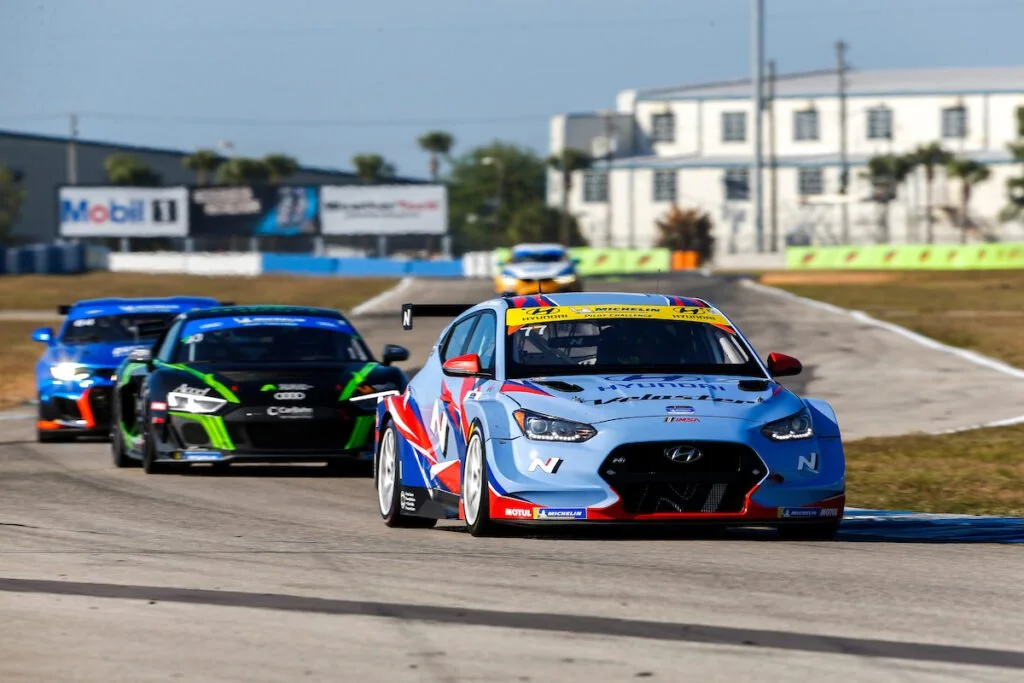Hyundai’s touring car trinity
Hyundai Motorsport’s new Elantra N TCR has already been a big hit in 2021. The new sedan TCR car is a strong seller and a title contender in WTCR, TCR Europe, and the IMSA Michelin Pilot Challenge series – with 21 cars already sold, after being announced just over a year ago.
Hyundai is the first manufacturer to produce a series of different cars for its customer racing programmes. While CUPRA, Honda, and Audi have all developed new cars, they’ve all been second-generation models of their respective racers, Hyundai has market specific cars across its range, first with the European-focussed i30 N TCR, then the US-ready Veloster, and now a racing version of the more widely available Elantra.
The car is not just a booted i30 however. The Hyundai Motorsport team has taken what it’s learned over four years with the successful hatchback, and put that all into the new Elantra.
Already a four-time race winner in WTCR, the Elantra’s an aggressive looking race car, and was already out on track before the roadgoing version of the Elantra N, which is expected to be a popular seller in the United States and Asia.
While the i30 was the first TCR model from the South Korean manufacturer, it wasn’t long until the Veloster made its debut at the start of 2019, with the car builder producing a car which would be relevant to the US market. The four-door coupé has so far just raced in the USA and the TCR Asia series, alongside some occasional appearances in the Nürburgring Endurance Series.
“The i30 N was the first of the road-going N line range of cars, so that was obvious that had to be our first TCR car,” said Andrew Johns, Hyundai Motorsport’s Customer Racing Manager.
“It was in 2018 that Bryan Herta Autosport were in the Pirelli World Challenge and were dipping their toe in the water with Hyundai USA. Towards the end of the year, they decided wanted to go to the IMSA series, and they felt they’d need a car that’s relevant to the America market, as the i30 N doesn’t exist over there.
“So, they asked if they could have a Veloster N TCR. That was signed off by our management HQ in Korea, and they ran that car in 2019-2020 in IMSA, and then our HQ then showed a desire in us also producing the Elantra N TCR.”
The approach means Hyundai Motorsport has relevant models for all its markets, since it has no global model.
“Here we have parts to build i30s, Velosters, Elantras, according to the customers’ requests,” explained Johns. “So, all three models are current; we can build any, with the Elantra being the newest of the three.
“If someone wanted a Veloster, we’d sell it if anyone wants one say in the UK, or Italy etc. but the real interest in that car was from the US - and now that we’re moved on to the Elantra, I don’t think we’ll really build many more Velosters, but we’ll support all those cars just as we would the i30 and the Elantra in equal measures.”
The Elantra made its debut in this year’s IMSA Michelin Pilot Challenge with Bryan Herta Autosport, and has since appeared in WTCR and TCR Europe series. The Elantra is a key seller in North America, where it is the second most popular road car in its class. And the TCR car is selling well too, with Hyundai confirming that its 20th and 21st Elantra N TCRs have just been shipped off the USA, where they’ll race in the Endurance Challenge event in support of the 24 Hours of Daytona next January.
“The Elantra is meant to be a worldwide car,” said Hyundai Motorsport Team Principal Andrea Adamo.
“It’s also sold in Central and South America, it will be in the Middle East, it could be that it’s sold much wider in the future, so it makes more sense”, he explained, giving the reason why the Elantra has been brought in as part of the brand’s touring car strategy.
“The i30 is very European. It’s something for us that’s fully alive for the regional and European markets, and it’s something on which we’re still working hard, even if the impression could be that we’re pushing the Elantra,” added Adamo. “The reality is we have two cars in TCR, that are dedicated to different championships and different markets.”
The Elantra is more than just a longer i30 however. With Hyundai Motorsport having put all its experience with the i30, which includes two WTCR drivers’ titles and a teams’ championship, to good use.
“The only thing that is the same between the two cars is the gearbox and the fuel tank,” said Adamo.
“It’s much better in terms of design and refinement. The experience we have with the i30 has not been wasted. I’m happy with the job we did there, so the Elantra is a much better car from many points of view; it’s not something you can just say is just a copy-paste and a bigger i30 – the car is totally different.”
The TCR Balance of Performance system ensures all cars are kept equal, and it’s already been seen in the USA and in TCR Europe that the Elantra is able to compete successfully alongside its ‘older’ i30 and Veloster siblings.
With the i30, Veloster, and Elantra, Hyundai Motorsport has shown adaptability with an approach which works in symmetry with the complex global road car market, where manufacturers often have different models competing in different regions. In doing so, national racing teams which are supported by Hyundai importers have a number of options available to them, and the TCR car market is all the richer with three models from Hyundai making up the 22 different TCR car models produced to-date.
This article appears in the October 2021 edition of TCR World & Life, the official TCR series magazine.



